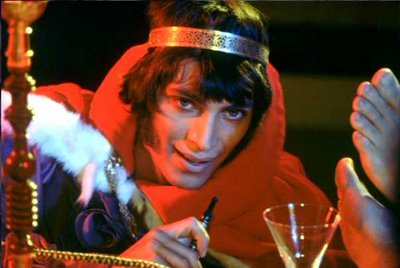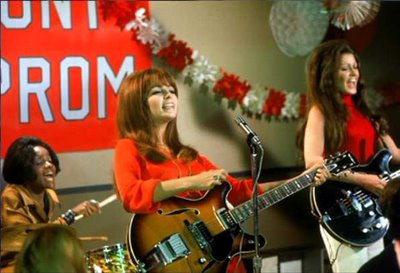The Kelly Affair (Marcia McBroom, Dolly Read and Cynthia Myers) perform at a midwestern school prom before becoming The Carrie Nations in BEYOND THE VALLEY OF THE DOLLS.
20th Century Fox Home Entertainment's two-disc set of Russ Meyer's cult classic BEYOND THE VALLEY OF THE DOLLS is one of those rare cases where an offbeat film is given all the love and indulgence even the most ardent fan could muster, proving once and for all that the film's place in history is now assured. Last night, I watched BVD (as it's known by cultists) no less than three times -- once in "stereo" (a kind of mono surround), and twice more with the two commentary tracks Fox has included (the first by screenwriter Roger Ebert, the second with cast members Dolly Read, Cynthia Myers, John La Zar, Erica Gavin and Harrison Page) -- and had to fight the impulse to watch it a fourth time in a row. This sparkling, anamorphic widescreen DVD gives the film the most beautiful presentation I've ever seen, and there is something about the film's manic energy, its polished irreverance, and the artistry underlying its rampant bad taste that is almost too rare in this world to voluntarily turn off.
They don't make movies like this anymore and, of course, they didn't really make them like this in 1969 either, which is why BVD had to endure so many years of mainstream disapproval as it grew in stature as (what Russ Meyer liked to call) the greatest cult movie of all time. Watching the film three times in a row gave me ample opportunity to pay attention to its innovative staccato cutting and even more innovative structuring, its use of flashbacks and flash-forwards, its chortling mixture of volatile dramatic and comedic chemicals (not to mention progressive and old-fashioned chemicals), its finale in triplicate. To see a movie so alive makes it all the more poignant to realize that Meyer is now gone, that there will be no more Meyer pictures... and this was another incentive to keep the film rolling, out of sheer denial that those days are over, when inspired lunatics like Meyer and Orson Welles could take over the asylum.
While making my way through the commentaries and extras, I was also struck by the many parallels between Meyer's career and that of Mario Bava. Both of them were cameramen, of course; both were also photographers who followed their wartime careers with what might be termed "fashion photography" (Meyer with PLAYBOY, Bava with the films of Gina Lollobrigida); both mades their names directing exploitation films, a level of production that gave them more opportunities to explore their creative/artistic freedom "under the radar" of the majors; both were complete filmmakers, in that they both worked with small crews and could effectively perform any crewman's task in a pinch, whether it was editing or selecting library music to assemble a soundtrack; both were recruited to make one big film for a major studio (Bava's was DANGER: DIABOLIK -- a similar Pop Art classic predating BVD -- for Paramount); and then both retreated back to the level of filmmaking they knew and loved, turning their backs on mainstream success. Also, both paid the price for turning back, working relatively little during their last ten years of life. The way Z-Man's hookah party is lit, with potent green and red gels, suggests to me that either Meyer or director of photography Fred J. Koenekamp were familiar with Bava's work.

John La Zar as Ronnie "Z Man" Barzell, entering into his third act persona as "Superwoman."
Perhaps the greatest compliment that I can pay to Roger Ebert's commentary is that at no time was I certain whether it was improvised or scripted. The talk is informative, personable, and amusing, and though it occasionally commits the sin of pride, that's usually understandable -- and one of the lesser sins on display in this programming. In addition to everything else he conveys, Ebert vividly communicates the pleasure he felt while actively writing several of the film's scenes, and he ventures some of his usually canny criticism toward the film in general and several of its performances. Ebert mentions that he has looked in vain for glimpses of Pam Grier in the party sequences, as I have; it was her first film, and the photo gallery includes two shots of her, proving that "Pamela Grier" -- as she's billed onscreen -- was there. There are some sound gaps later in the track, which one wishes had been spent covering some of the scenes that didn't make the final cut, which are documented in the stills gallery; instead, Ebert reminiscences about working with Meyer and The Sex Pistols on the ill-fated WHO KILLED BAMBI?. On the whole, the track isn't up to Ebert's commentary for DARK CITY (a masterpiece of the form, by my reckoning), but his personal stake in this one gives it a more vital aspect, perhaps, than perfection.
On the whole, the cast commentary track I found more compelling because of the stew of personalities it offers. Everyone seems touched, even wounded, to see how young they are onscreen, but the screening is largely jubilant, with everyone noting their favorite lines and scenes and laughing at the memory of Meyer's "Don't blink!" approach to directing actors. Two of the actors in the film had their first screen kisses with members of the same sex, and BVD's homosexual content is perhaps the most interesting lightning bolt to conversation; Erika Gavin had a real crush on Cynthia Myers during the filming (you can see it in the way Erika is focused on Cynthia even in the production stills), which raised the temperature of their tender love scenes together, and John La Zar admits (perhaps facetiously) that his screen kiss with Michael Blodgett prompted years of psychiatric therapy. Watching Erika and Cynthia onscreen together, to Harrison's effusive approval, Dolly Read drops her guard and admits that husband Dick Martin tried to get her to have threesomes with other women in those days (and, when she continually refused, the LAUGH-IN star finally married her). I expected John La Zar to dominate the session, which he does to some extent through passive aggression, sulking in silence through large patches and apologizing for occasionally interrupting "The Dolly and Harrison Show." They do talk a good deal, but much of what they have to say is generous in nature, showing appreciation for other performers or the film's construction. On La Zar's behalf, he does seem to have paid more attention during the filming, or studied the film more closely since making it, than the other participants; he knows all the names no one else remembers, and often has anecdotes to back up his trivia. Erika Gavin is perhaps the most passive of the participants, but it's a great moment when she realizes that Dolly is cavorting onscreen in an orange chiffon nightgown that she wore earlier in VIXEN. All the commentators seem rather amazed to realize that Duncan McLeod, who plays smarmy lawyer Porter Hall, probably had the biggest part in the movie.
The second disc is a non-stop parade of winning supplements, beginning with John La Zar's on-camera introduction "in character" and ranging from production featurettes (incorporating on-camera interviews with many cast and crew members) to teaser trailers and theatrical trailers with their own little surprises; one of the teasers is an amazing document showing Meyer at work on the set as a stills photographer, and the theatrical trailer is a riot, nearly heart-bursting in its hyperbolic bravado. The detailed and thorough stills gallery is fascinating for its inclusion of various unexplained shots from scenes not included in the film, including some picturing Dolly Read in elderly makeup as her own deceased aunt. The detailed coverage of the film's music, featuring interviews with producer Stu Phillips and vocalist Lynn Carey (the daughter of actor MacDonald Carey), is especially enjoyable and the music itself, along with Read's dead-on pantomiming of Carey's lusty vocals, is a big reason for the film's repeatability. My only complaint about the set (and it's a minor one) is that some of the featurettes take too much of a E!-list approach to celebrating the movie. Do we really need to know various peoples' opinion of who had the best breasts in the movie? Probably not, but if truth be told, the question provokes some enjoyable responses. All in all, the supplements do a commendable job of addressing themselves to the full spectrum of BVD's admiring audience.
In the realm of cinema, the time-honored definition of "classic" is a movie that gets better with age, like a fine wine. BEYOND THE VALLEY OF THE DOLLS is a rarer breed still; a film that intended to represent its time but didn't get it quite right. This error was a blessing in disguise, as BVD now seems to exist outside of time in the traditional sense. With each passing year, it not only gets better, it seems to get smarter and younger, too.
Yesterday's X rating, today's wide-eyed innocence. Count me among those proud to be in its thrall.
